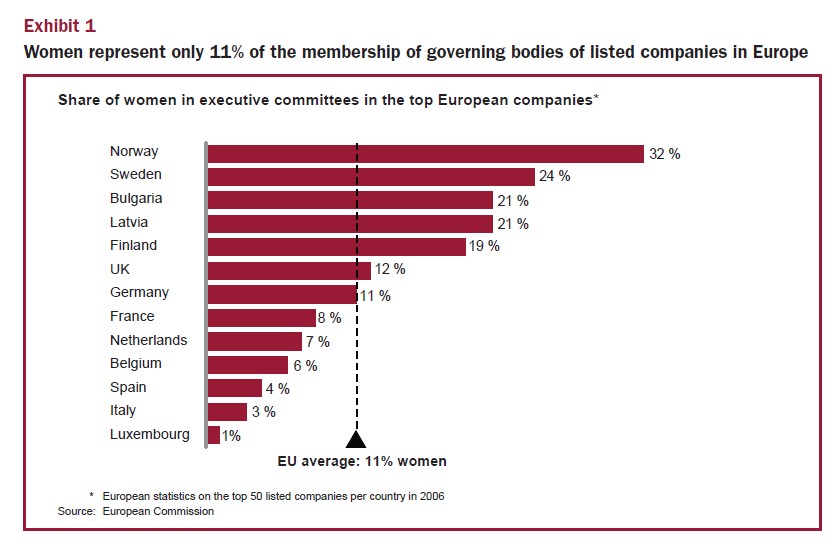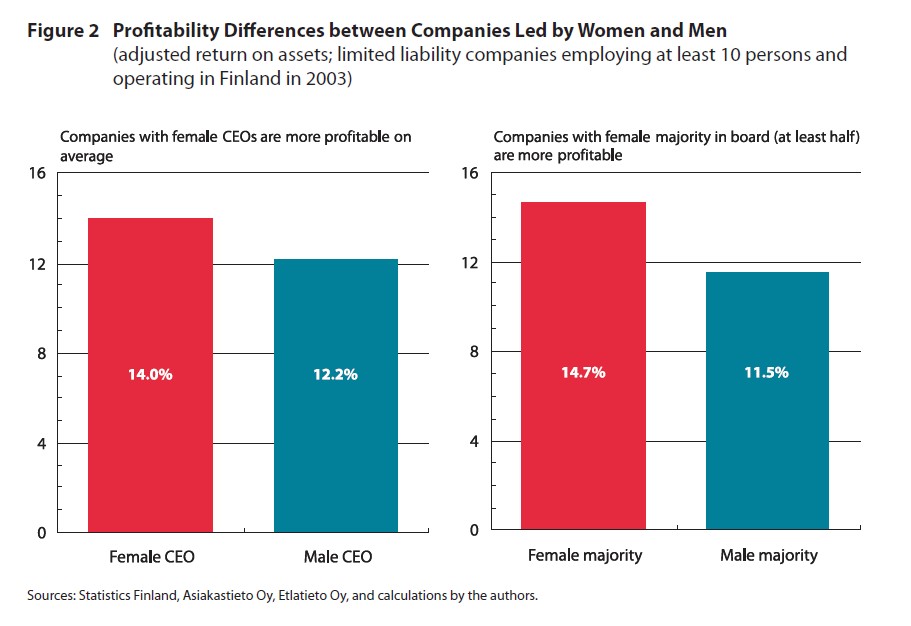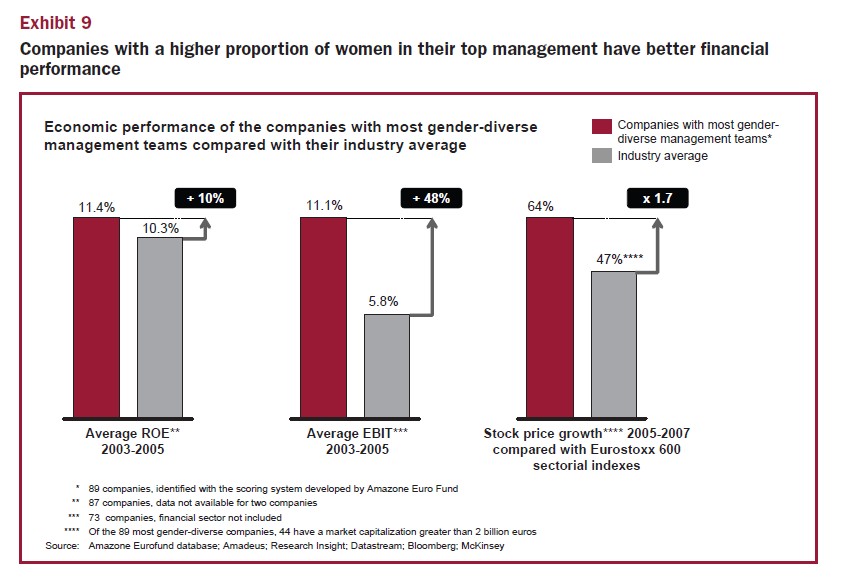Gender Equality in Corporate Boards
 “At a time when we are exposed to a risk of slowing economic growth and rising unemployment in the wake of the public debt crisis, we cannot ignore the potential of half the population.” Viviane Reding, vice president of the European Commission and European Commissioner for Justice and Françoise Grossetête, European Parliament member from France.
“At a time when we are exposed to a risk of slowing economic growth and rising unemployment in the wake of the public debt crisis, we cannot ignore the potential of half the population.” Viviane Reding, vice president of the European Commission and European Commissioner for Justice and Françoise Grossetête, European Parliament member from France.
Table of Contents
- 1 Data and Country Focus
- 2 Factors affecting the proportion of women on corporate boards
- 3 Benefits of the presence of women in corporate boards
- 4 How to obtain gender equality on corporate boards?
- 5 20-first’s Global Gender Balance Scorecard 2012: Focus on Natural Resources Industry
- 6 See also
- 7 References
Data and Country Focus
European Union
- Women represent 11% of company boards’ members (2006).
- 3% of CEOs are women.Viviane Reding and Françoise Grossetête, “Quotas for Women on Corporate Boards: Why not?” in Les Echos, March 02, 2011.

Norway
Norway was the first country to implement a 40% quota of women on boards (2003) with severe sanctions. Following this reform, the share of women on corporate boards increased from 25 percent in 2004 to 42 percent in 2009.Spain
Spain followed the Norwegian example in 2007 by adopting a similar law (goal of 40% of women on corporate boards in 2015). As a result, the participation of women on boards has risen from 4 percent in 2006 to 10 percent in 2010.Iceland
A law passed in March 2010 requires Iceland companies with more than 50 employees to have at least 40% of both gender represented on their boards by September 2013.European Women’s Lobby response to the European Commission’s Green Paper “Corporate governance in financial institutions and remuneration policies”
France
In January 2010, a law was passed requiring France firms of more than 500 employees to reach a quota of 20% of women on corporate boards within three years and of 40% by 2017. In October 2010, about one third of the concerned third reached the 20% goal, but the average was 7%.«”Lady boom dans les conseils d’administration des entreprises cotées” on Capital.fr, October 20, 2010.
Finland
- Less than 1/10 of Finland firm’s CEO and chairmen of the boards are women.
- 23,6% of corporate boards are composed by women.
United States
- Women represent 47% of the Gender Equality in the Gender Equality in the United States of America of America workforce (data of 2009)…
- … but only 14% of executives.
- They occupy 11% of Fortune 1000 companies board seats less than 16% of board seats at public companies.
- 25% of Fortune 1000 companies do not have any women on their boards.2010 Catalyst Census: Fortune 500 Women Board Directors
Factors affecting the proportion of women on corporate boards
Several factors are usually considered to affect the access of women to corporate boards. Among them, Siri Terjesen and Val SinghSiri Terjesen and Val Singh, “Female Presence on Corporate Boards: A Multicountry study of Environmental Context” in Journal of Business Ethics, 2008. identify:
- The lack of ambition and confidence
- The lack of leadership skills (assertiveness, influencing behavior)
- The lack of relevant experience or education for leadership
- The lack of involvement in corporate networks. In fact, it is often impossible for women to attend late meetings or business dinner because they have commitments at home. And yet, networking happens at these moments. Women are therefore excluded from the possibility of networking de facto.
- Under-representation of senior women managers. Which causes:
- Female employees to lack a workplace role-model (as it is easier to identify with someone from the same gender)
- Lack of homosocial reproduction. It is believed that a woman will be more likely to hire another woman and vice versa, for the simple reason that people tend to prefer working with people similar to them, because they can understand and predict their behavior . This homosocial reproduction is especially true in corporate relations between men and women.Jody Rosener, « Women on Corporate Boards Makes Good Business Sense » on womensmedia.com, April 02, 2009.
- The typical career path of a leader is expected to be unbroken. This makes it difficult for women as this belief does not take into consideration the possibility of maternity leave.
- The gender pay gap is also considered to be a cyclical guard against promotions as high pay is generally considered as an individual assessment. It is therefore taken into account when deciding whether or not to promote someone. And yet, it is well known than women are less paid on average than men. As a result, they are less likely to be promoted.
Benefits of the presence of women in corporate boards
One of the questions always at the forefront of the debates about gender equality consist of wondering whether women have to be considered as different than men (having their own qualities) or whether they have to be considered as equal to men (and granted equality as a consequence of this mentality). Siri Terjesen and Val Singh posit that the presence of women on boards of directors is beneficial due to their specific qualities. Among these qualities, they identify:
- Their ability to bring new ideas and improve communication
- Their use of influence and inspiration instead of command and control
- Their facility to provide insight on female market consumers. As James Preston, retired CEO of Avon Products Inc.has said, we can indeed consider that as “60% of all purchases in this country are made by women, having women on the board just makes good business sense”Catherine M. Daily, S. Trevis Certo, Dan R. Dalton, “A Decade of Corporate Women: Some Progress in the Boardroom, None in the Executive Suite” in Strategic Management Journal, Vol. 20, No. 1 (Jan. 1999).
- Also, having more women on corporate boards is beneficial as they represent career opportunities for potential female employees (as we have previously seen, a lack of women at a high level in the firm can prevent other women from aspiring to move up the ranks of the hierarchy).
Judith B. Rosener, also underlines that women are useful on corporate boards because they bring new ideas, but above all, they bring a new way of seeing things. Because of their different background, women tend to see the problems and their respective solution differently. Moreover, thanks to their quality as “outsiders”, they do not hesitate to ask questions as much as men might.
Better results?
A Finnish study found that firms with a female CEO or with corporate boards composed of at least half of women have better results than the others:
- Profitability of firms: average = 12.3% ≠ with a female CEO = 14%
- Profitability of firms with a corporate boards composed of a least half of women: 14.7% (v. 11.5% for the others)Annu Kotiranta, Alle Kovalained, Petri Rouvinen, “Female Leadership and Firm Profitability”, Eva Analysis, September 24 2007.

These sorts of results were confirmed by a study by the consulting firm McKinsey, showing that the operating income of companies with majority of women on their boards is 56 percent higher than that of businesses with exclusively male boards of directors.« Women Matter – Gender diversity, a corporate performance driver”, study by McKinsey &Company (2007).

How to obtain gender equality on corporate boards?
What to do in firms?
The consulting firm McKinsey has laid out four criteria that create a favorable atmosphere for the development of gender equality in a firm:
1. Create transparency by implementing gender diversity indicators
Gender diversity indicators are essential to evaluate the depth of the gender gap in the firm and a way of setting the objectives to reach. It is therefore necessary to take into consideration:
- The proportion of women in the company’s various business lines, at each level of management and among new recruits
- Pay levels and attrition rates between men and women in similar functions
- Ratio of women promoted to women eligible for promotion
However, McKinsey reject the use of quotas.
2. Implement measures to facilitate the work-life balance
- Flexible working hours
- Career flexibility and support during break
3. Adapt the human resources management process
For instance, companies generally focus their hiring process of high potential managers on persons between the age of 28 and 35. To prevent women from being prejudiced by this criteria, McKinsey suggests to establish more flexible criteria, more focused on the number of years of service in the company. The main idea here is that firms have to abandon their traditional selection processes and adopt more flexible ones, in order to adapt to the market.
4. Help women master the dominant codes, nurture their ambition
This consists in coaching, network-building and mentoring program in order to allow women to be aware of their full potential and of the different opportunities that are offered in the firm.
Women, now it’s your turn!
Gender equality in boards of directors necessarily implies that companies are aware of the potential represented by women. But more importantly, women themselves have to stop censuring their inner goals. It is now their turn to take action to get seats on company boards. Here are some advice given by Stepheny Overman:Stephenie Overman, « How can more women land sports on company boards ?” on CNNMoney.com, March 11, 2011.
- Networking: “You have to network. Challenge your friends who are CEOs. Tell them you’re interested in joining a board, so they have you in the back of their mind” when an opening becomes available.” (Libby Sartain, member of the boards of Pett’s Coffee and Ta Inc. and Manpower Inc.)
- Finding a mentor: “Not only can a mentor help with career development, but at a critical moment, they can validate you. When you have a relationship with someone, they can say ‘I know her and she’s terrific.'”” (Aida M. Alvarez, member of the board of directors of Wal-Mart Stores Inc. and Union Bank N.A.)
- Trying in non-profit: the door is more opened to women in this domain and there are many links between non-profit and for-profit boards of directors, so it could be a good first experience.
- Show what you are doing: “I think women have a tendency to work late and hope their work gets noticed. Let people see. It helps your career. You have to be in the arena to be seen and to be a leader.” (Susan Stautberg, co-founder of Women Corporate Directors).
20-first’s Global Gender Balance Scorecard 2012: Focus on Natural Resources Industry
- In a sample of 24 companies, there are a total of 221 Executive Committee members (i.e. the group of executives who report directly to the CEO).
- 92% of these Executive Committee members are men (203); 8% are women (18).
- Of the 18 women, most of them (14, 6% of total) are in staff or support roles. Only 4 women (2% of the total) are in line or operational role.
- Notable companies include Anglo American, the only company of this sample with a female CEO. Marathon Oil has achieved critical mass on its team, with 33% of the team made up of women (3 women and 6 men). Repsol YPF and Rio Tinto are just behind with 25% women on their top teams.
Access the 2012 Gender Balance Scorecard.


